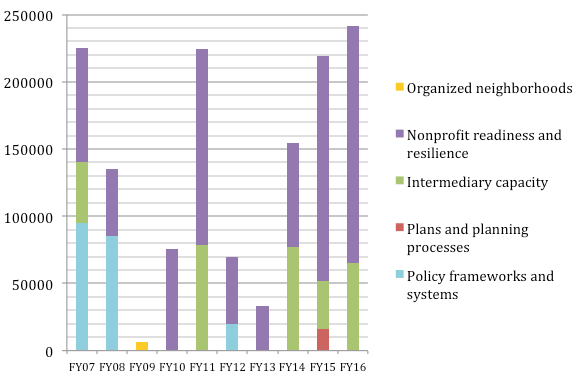Disaster Philanthropy Playbook
Incorporating Disaster Response Into All Levels of Foundation Work
Hurricane Katrina hit the Gulf Coast in 2005 with visibly disproportionate impact on low-income communities and communities of color. Leadership at The San Francisco Foundation recognized that what had happened in Katrina could also occur in the Bay Area and that vulnerable communities and the organizations that serve them are often marginalized and under-resourced, and therefore often also the least prepared. In response, TSFF developed a disaster resilience project that was nested within its Community Health program, beginning our engagement in the disaster resilience field with several grants to the Bay Area disaster intermediaries that help prepare community-based organizations serving vulnerable residents.
A more extensive disaster resilience program was established in late 2007, beginning with externally-facing outreach and training activities at the neighborhood level in a modest number of low-income communities and communities of color. Over the nine years of its disaster resilience work, San Francisco Foundation staff developed and implemented a robust and comprehensive program, contributing in various ways and to varying degrees to six elements of disaster resilience.

Program highlights have included:
Immediate Disaster Relief Grant Program – The Foundation has pre-approved immediate relief grants to 42 nonprofits that serve vulnerable communities in our five-county area to support the delivery of food, shelter, health, and/or mental health services in the early days following a catastrophic disaster. Each of these organizations will receive a $25,000 grant upon confirmation that it has begun delivering services post-disaster.
Technical assistance and training – The Foundation supported technical assistance on disaster planning for all organizations in the Immediate Disaster Relief Grant Program. These organizations committed to developing, maintaining, and practicing robust disaster plans to recover their operations and provide services to their clients and community in the aftermath of a large Bay Area disaster. The Foundation will continue to supporting technical assistance by local intermediaries for this purpose through June 2017.
Advocacy – TSFF advocated for adequate funding for nonprofits before, during, and after disaster through implementation of California’s Private Non-Profit Disaster Reimbursement Program, government recognition of the role of nonprofits in disaster and the need for inclusion in planning, and increased foundation sector funding to nonprofit disaster preparedness;
Capacity-building – TSFF provided support to local intermediaries, including local Voluntary Organizations Active in Disaster (VOADs), that support the readiness and resilience of the broader Bay Area nonprofit and faith-based communities.
Grantmaking – The Foundation granted nearly $1.4 million to the Bay Area nonprofit sector from 2007 through 2016 for disaster resilience, supporting five of the six elements.

Convenings – TSFF hosted three summits on disaster resilience. The first, Building a Disaster-Resilient Bay Area: Lessons for Strengthening Vulnerable Communities (April 2009), shared lessons and sparked dialogue on community resilience. The summits in 2010 and 2013 specifically focused on strengthening the Foundation’s disaster cohort, Deepening Your Readiness: A Hands-On Summit to Share Best Practices, Test Your Planning Assumptions, and Strengthen Your Networks and Plans (October 2010) and Collaboration in Disaster: Promising Practices And Pitfalls (June 2013). These latter summits included opportunities to learn about specific disaster topics, practice disaster skills, learn from leaders of nonprofits responding to previous large-scale disasters (e.g., LA riots, Hurricane Sandy), connect with disaster intermediaries and emergency managers from their jurisdictions, and share best practices with one another. TSFF also hosted convenings on specific technical assistance topics and for networking among nonprofits, government leaders, and funders.
Thought-partnership and –leadership – TSFF partnered with a variety of leaders in the philanthropic, nonprofit, and public sectors on disaster grantmaking strategies and processes, support for the nonprofit sector for disaster, public-private partnerships to manage donations after a disaster, approaches to promoting community resilience, and philanthropic collaboration models for disaster and a greater philanthropic constituency for the field.
Robust internal planning – The Foundation complemented its external, community focused work with internal planning to develop and practice our own disaster procedures to enable TSFF to support the community after a catastrophic disaster. Aspects of these plans have been shared with philanthropic partners in the Bay Area and around the country.
The project received financial support from three foundation partners – The California Endowment, Walter and Elise Haas Fund, and Y&H Soda Foundation.
In June 2016, The San Francisco Foundation launched an ambitious new strategy to advance racial and economic equity across the Bay Area to ensure that everyone has a chance to get a good job, live in a safe and affordable home, can be part of a truly inclusive democracy, and can live in a community that provides real access to opportunity. While our work on racial and economic equity will strengthen the resilience of Bay Area communities, we will exit disaster resilience as a discrete body of work at the end of this month. Final grants to our partnering organizations were made in June 2016, and wrap-up work will be completed by August 31, 2016.
Specific questions about the Disaster Resilience program should be directed to vpprograms@sff.org.